
Solar Energy
Scope & Guideline
Illuminating the path to renewable energy breakthroughs.
Introduction
Aims and Scopes
- Solar Photovoltaics (PV):
Research focusing on the design, efficiency, and performance of solar photovoltaic systems, including advancements in materials such as perovskites, organic solar cells, and thin films. - Solar Thermal Energy Systems:
Studies on solar thermal collectors, heat exchangers, and thermal energy storage systems, including hybrid systems that integrate solar thermal with other energy sources. - Photocatalysis and Environmental Applications:
Investigations into the use of solar energy for photocatalytic applications, including water purification and hydrogen production, as well as the environmental impacts of solar technologies. - Energy Management and Policy:
Research on the economic, environmental, and social aspects of solar energy, including policy frameworks, market analyses, and energy management strategies. - Innovative Solar Technologies:
Development and analysis of new technologies and materials for solar energy harvesting, including advanced coatings, nanomaterials, and hybrid systems.
Trending and Emerging
- Perovskite Solar Cells:
There is a significant increase in research focused on perovskite solar cells, including stability improvements, efficiency enhancements, and applications in tandem configurations. - Machine Learning Applications:
The integration of machine learning techniques for performance prediction, fault detection, and optimization in solar energy systems is rapidly gaining traction. - Bifacial and Floating Solar Technologies:
Emerging interest in bifacial solar panels and floating solar systems is evident, driven by the need for land-efficient and versatile solar installations. - Solar Energy in Agriculture (Agrivoltaics):
Research on integrating solar energy solutions with agricultural practices is trending, as it presents a dual-use opportunity that maximizes land efficiency. - Sustainable Materials and Recycling:
Investigation into sustainable materials, recycling of solar components, and the environmental lifecycle of solar technologies is becoming increasingly prominent.
Declining or Waning
- Traditional Solar Thermal Technologies:
While still relevant, conventional solar thermal technologies have seen a waning interest in favor of more innovative and integrated systems, such as PV/T and hybrid solar solutions. - Single Junction Solar Cells:
The research focus on single-junction solar cells is declining as the community shifts towards tandem and multi-junction systems that promise higher efficiencies. - Basic Solar Energy Policies:
Interest in basic policy discussions around solar energy has decreased, with more emphasis now on complex socio-economic impacts and integration strategies. - Solar Energy in Urban Contexts:
Research specifically addressing urban solar energy applications is becoming less prominent, as studies increasingly focus on broader, integrated approaches such as agrivoltaics and community energy systems.
Similar Journals
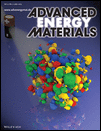
Advanced Energy Materials
Pioneering the Future of Sustainable MaterialsAdvanced Energy Materials is a leading academic journal published by WILEY-V C H VERLAG GMBH, focusing on the rapidly evolving fields of materials science and renewable energy technologies. With an impressive impact factor and recognition as a top-tier journal, it ranks within the Q1 category in both Materials Science (miscellaneous) and Renewable Energy, Sustainability and the Environment as of 2023. Spanning from 2011 to 2024, the journal serves as an essential platform for researchers, professionals, and students eager to explore groundbreaking advancements in energy materials, fostering innovative solutions to global sustainability challenges. The journal's authoritative content is supported by rigorous peer review, ensuring high-quality research contributes to the academic community and beyond. Located in Weinheim, Germany, Advanced Energy Materials stands at the forefront of scientific inquiry, making it an invaluable resource for those invested in the future of energy and materials science.
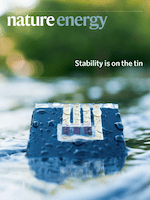
Nature Energy
Transforming energy challenges into innovative solutions.Nature Energy is a leading academic journal focused on the multidisciplinary field of energy research, published by NATURE PORTFOLIO. Since its inception in 2016, the journal has rapidly established itself as a key platform for innovative research on energy technologies, sustainable practices, and advancements in renewable energy sources. With an impressive impact factor and consistently ranked in the Q1 category across various disciplines, including Electronic, Optical and Magnetic Materials, Energy Engineering, and Fuel Technology, Nature Energy attracts a global audience of researchers and professionals committed to addressing the pressing energy challenges of our time. Its Scopus rankings highlight its exceptional standing in the field, with leading positions in Energy Engineering and Renewable Energy categories, underscoring its importance in shaping future energy strategies. For those looking to contribute to the discourse on sustainable energy solutions, Nature Energy offers an engaging avenue for dissemination of cutting-edge research and innovative ideas.

Joule
Igniting Innovation in Energy ResearchJoule, published by CELL PRESS, is a premier journal dedicated to the rapidly evolving field of energy research. Since its inception in 2017, Joule has established itself as a leading source of high-impact studies in energy, achieving an outstanding Q1 ranking in the Energy (miscellaneous) category and ranking #1 out of 73 in the general energy field, placing it within the 99th percentile according to Scopus metrics. The journal aims to advance the understanding of diverse energy forms and their applications, providing a platform for significant breakthroughs that can drive sustainable practices and innovative technologies. Through rigorous peer review and expert contributions, Joule serves as an invaluable resource for researchers, professionals, and students engaged in tackling some of the most pressing energy challenges of our time. Based in the United States, Joule continues to foster collaboration and interdisciplinary approaches in energy research, striving to illuminate pathways toward a sustainable future.

INTERNATIONAL JOURNAL OF PHOTOENERGY
Driving Interdisciplinary Insights in Renewable EnergyThe INTERNATIONAL JOURNAL OF PHOTOENERGY, published by HINDAWI LTD, is a pivotal open-access journal that has been advancing knowledge in the field of photoenergy since its inception in 1999. With an impact factor that reflects its growing influence in the scientific community, the journal spans a range of critical categories, achieving Q2 rankings in Atomic and Molecular Physics, Chemistry, and Materials Science as of 2023, as well as a Q3 ranking in Renewable Energy. The journal supports research dissemination through its open-access model, empowering global access to high-quality studies that explore innovative applications of light energy. Housed in the United States with a dedicated focus on interdisciplinary research, the INTERNATIONAL JOURNAL OF PHOTOENERGY serves as an essential platform for researchers, industry professionals, and academics aimed at solving today's energy challenges and promoting sustainability through the harnessing of photoenergy.
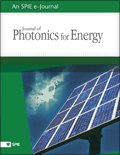
Journal of Photonics for Energy
Harnessing Light for Sustainable ProgressJournal of Photonics for Energy is a prominent academic journal dedicated to advancing the field of photonics with a specific emphasis on its applications in energy-related technologies. Published by SPIE-SOC PHOTO-OPTICAL INSTRUMENTATION ENGINEERS, this journal serves as a vital platform for researchers, professionals, and students alike to disseminate and discover groundbreaking findings that integrate photonic systems and renewable energy solutions. The journal has established itself as an influential resource in the fields of Atomic and Molecular Physics, Optics, as well as Renewable Energy, achieving a respectable Q3 category ranking in both categories as of 2023. Although it is not an open-access publication, it provides robust insights and access options that facilitate the sharing of innovative research. With over a decade of contributions since its inception in 2011, the Journal of Photonics for Energy is positioned at the intersection of science and sustainability, making it essential for anyone engaged in the pursuit of energy efficiency and environmental responsibility.
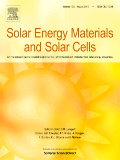
SOLAR ENERGY MATERIALS AND SOLAR CELLS
Innovating Materials for a Sustainable TomorrowSOLAR ENERGY MATERIALS AND SOLAR CELLS is a distinguished academic journal published by Elsevier, based in the Netherlands, focusing on innovative research in the fields of materials science and renewable energy. With a substantial history dating back to 1970, the journal has evolved into a premier platform for disseminating advanced studies related to solar energy technologies, including the development and optimization of solar cells and materials. Recognized for its high impact, the journal maintains a Q1 ranking across multiple relevant categories such as Electronic, Optical and Magnetic Materials, Renewable Energy, Sustainability and the Environment, and Surfaces, Coatings, and Films. It ranks impressively within the top tiers of Scopus, showcasing its influence and relevance in the scientific community. Although it does not offer open access, the journal remains a crucial resource for researchers, professionals, and students aiming to contribute to the advancement of sustainable energy technologies and materials innovation.
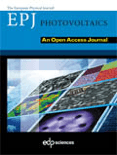
EPJ Photovoltaics
Illuminating the path to renewable energy solutions.EPJ Photovoltaics, published by EDP Sciences S.A., is a distinguished open-access journal dedicated to advancing the field of photovoltaic research and technology. Established in 2011, and operating from France, the journal serves as a vital platform for researchers, professionals, and students interested in the innovative possibilities of solar energy conversion. With a broad scope encompassing condensed matter physics, electrical and electronic engineering, and renewable energy, EPJ Photovoltaics boasts a commendable Q2 ranking in key categories as of 2023, showcasing its relevance and impact in the scientific community. Researchers will find an opportunity to disseminate their findings effectively, as the journal offers rapid publication options that align with the fast-paced evolution of the field. This publication not only contributes to academic discourse but also plays a crucial role in addressing global energy challenges, making it an essential resource for anyone invested in the future of sustainable energy technologies.

Advances in Energy Research
Shaping the Future of Energy with Groundbreaking Research.Advances in Energy Research is a prominent journal dedicated to the exploration and advancement of energy technologies and sustainable practices. Published by TECHNO-PRESS, this journal serves as a vital platform for researchers, professionals, and students in the energy field, featuring innovative studies and reviews that contribute to the body of knowledge surrounding energy efficiency, renewable resources, and the integration of new technologies. The journal holds a significant position in energy research and aims to facilitate the dissemination of groundbreaking findings and ideas that are pivotal for the transition toward a more sustainable energy future. Located in South Korea, with an ISSN of 2287-6316, it embraces an open access philosophy that ensures widespread availability of its content, further enhancing its impact in the academic community.
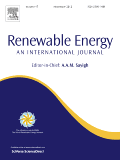
Renewable Energy
Innovating Tomorrow's Energy Solutions.Renewable Energy is a prestigious international journal published by PERGAMON-ELSEVIER SCIENCE LTD, dedicated to advancing the field of renewable energy technologies and their applications. Since its inception in 1991, this journal has provided a critical platform for researchers, professionals, and students to explore innovative solutions in renewable energy, sustainability, and environmental protection. With an impressive impact factor and ranked in the top quartile (Q1) of its category, Renewable Energy is recognized for its high-quality, peer-reviewed research that significantly contributes to the scientific and professional discourse in the sector. The journal is indexed in Scopus, holding an esteemed rank of #21 out of 270 in its field, underscoring its influence and reach. Researchers can access the journal’s articles through traditional subscriptions, ensuring a broad dissemination of vital knowledge that supports the global transition to sustainable energy sources. Addressed from its headquarters in Oxford, England, Renewable Energy is crucial for anyone involved in the journey towards a sustainable future, fostering collaboration and innovation in a critical area of environmental science.

Renewable Energy Research and Applications
Empowering Sustainable Solutions for Tomorrow's Energy NeedsRenewable Energy Research and Applications is an esteemed academic journal published by Shahroud University of Technology, dedicated to advancing the field of renewable energy and its diverse applications. Since its inception in 2020, this Open Access journal has provided a platform for publishing innovative research that addresses the critical challenges and opportunities within the renewable energy sector, including solar, wind, hydro, and biomass energy. With an ISSN of 2717-252X and an E-ISSN of 2676-7430, the journal aims to disseminate high-quality research findings that inform policy makers, researchers, and practitioners worldwide. By fostering collaboration and knowledge exchange, the journal plays a vital role in the ongoing transition towards sustainable energy solutions, making it an essential resource for anyone committed to this urgent global challenge.